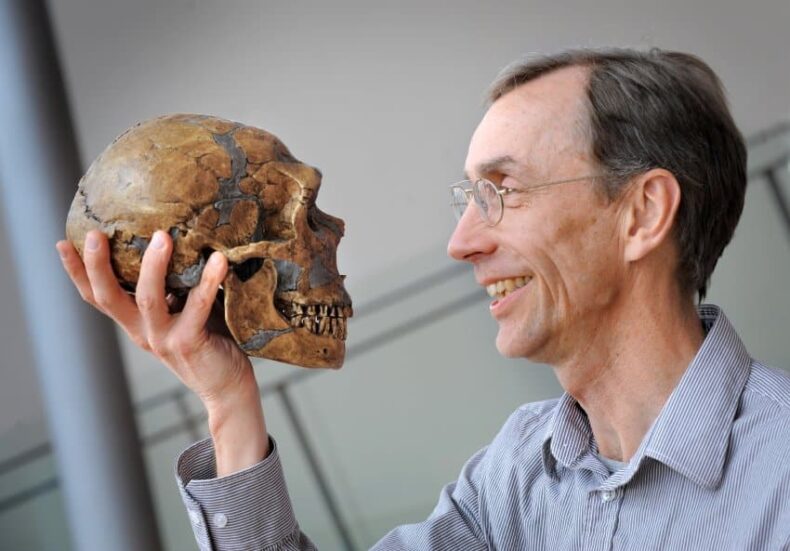
Svante Paabo was born on 20th April 1955 in Stockholm, Sweden. He was born to mother Karin Paabo and father Sune Bergstrom. He took his mother’s surname as he was born as a result of his father, Swedish biochemist, Svante Paabo’s extramarital affair with his mother.
Svante Paabo is a Swedish genecist specializing in the field of evolutionary genetics. He also co-founded the stream of Genetics called Paleogenetics.
Paleogenetics is the study of the past through the examination of preserved genetic material from the remains of ancient organisms.
Svante Paabo received the Noble Prize for medicine 2022 for his remarkable work in human evolution.
He was awarded the prize for genome sequencing of our extinct relative, the Neanderthals and also for discovering the presence of an unknown human relative which he called the Denisovans.
In 1997, the Max Planck Institute for Evolutionary Anthropology was co-founded by director Svante Paabo. It is a research institute based in Leipzig, Germany. It is where Paabo performed all of his historic discoveries.
Paabo along with his team of scientists successfully discovered a Neanderthal mitochondrial DNA (mtDNA) which they extracted from an ancient specimen found in the Feldhofer grotto of the Neander Valley.
In 2006, the Neanderthal Genome Project was founded by the Max Planck Institute for Evolution Anthropology in collaboration with a US based biotechnology company called 454 Life Sciences. It was an effort made by group of genetic scientists to sequence the Neanderthal genome. Team led by Paabo announced that he will be reconstructing the entire genome of the Neanderthals.
Three years later, the institute submitted their first draft of Neanderthal Genome. This study showed no signs of similarity between the genes of Neanderthals and modern-day humans.
In 2010, another report was submitted by Paabo and his team contradicting the previous reports.This time the draft said that nucleotide sequences of Neanderthal genome and modern human genome is more similar than that of Chimpanzees and modern human genome.
Exactly this year, history threw another hint at science when a new report was submitted on a study related to a finger bone found in Denisova Cave in Siberia.
This report said that there was a DNA found that was different from the DNA extracted from Neanderthals, Chimpanzees and modern-day humans.
The report suggested that bone belonged to an extinct species of the archaic humans which hasn’t been recognized all these years. It was named Denisova hominin.
In 2022, Paabo’s study reported how post COVID-19 impacts on modern human beings are similar to that of the European Neanderthals, through DNA analysis.
Apart from this he also wrote a book based on his researches, Neanderthal Man: In Search of Lost Genomes.

The Noble Prize committee acknowledged the genecist huge contribution to the society. It said that Svante Paabo’s research has helped us to know more about our evolutionary history, how our extinct relatives, the Neanderthals, seized to live but on the other hand we, the Homo sapiens, persisted.
Another remarkable fact about Svante Paabo is that he is the son of a Noble laureate himself.
Paabo’s father, Karl Sune Deltof Bergstrom, was a Swedish biochemist. The biggest coincidence was that both father and son received the Nobel in the same category, medicine.
Sune Bergstrom was awarded the Nobel Prize in medicine in 1982 for discoveries concerning prostaglandins and related substances. He shared the Nobel with two others.
The prostaglandins (PG) are a group physiologically active lipid compounds called eicosanoid having diverse hormone-like effects in animals.
In 1950s, Bergstrom produced artificial prostaglandins and determined the chemical structures of two important prostaglandins, PGE and PGF. He also determined that these are formed through the conversion of unsaturated fatty acids.
Prostaglandins have several clinical uses which makes this discovery so important. It is used to induce labor during child birth and abortion as it mediates uterus contraction, as a vasodilator, treatment of glaucoma, to prevent closure of ductus arteriosus in newborns with particular cyanotic heart defects and to treat so many more diseases.

Both Sune Bergstrom and Svante Paabo winning the Nobel 40 years apart in the same category is not a very usual scene and has happened very rarely in history which confirms the fact that the finest of genetic material has been transferred from one generation to the next inside this family without a doubt.













